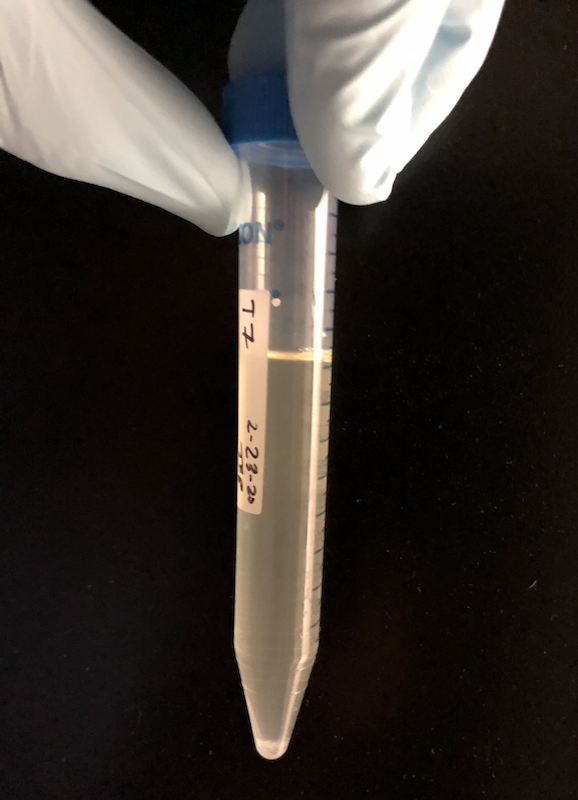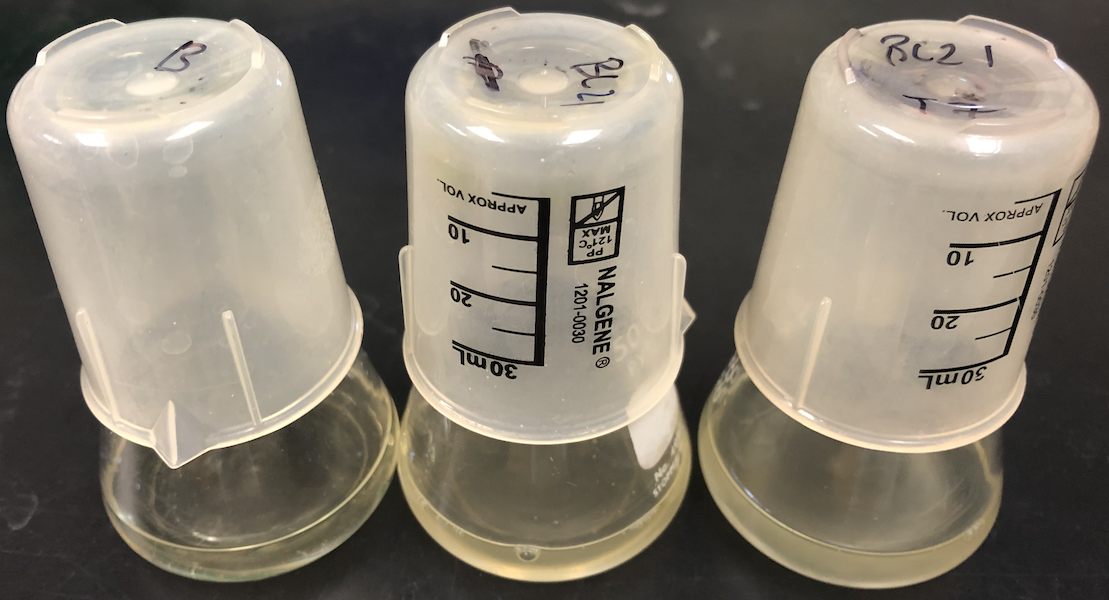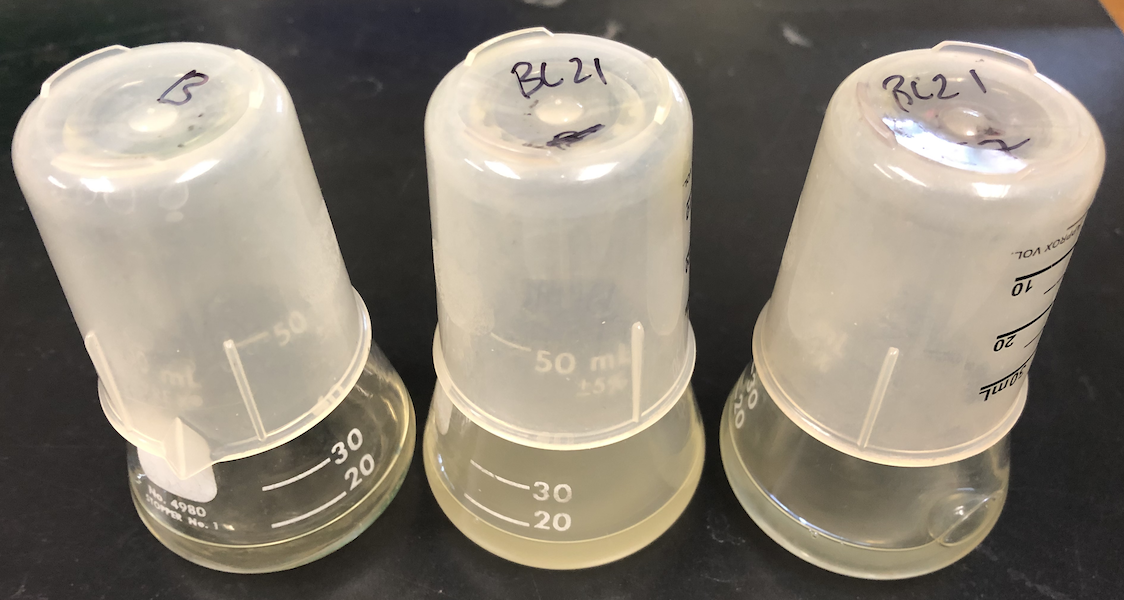
Difference: ProtocolPhageLysate (1 vs. 8)
Revision 82022-08-03 - JeffreyBarrick
Phage Lysate PreparationWe have used this protocol with phages T4, T5, T6 and T7. The general procedure should work with most lytic E. coli phages (although lysis times and final titers may differ). See the variants section for some ways to modify it for other hosts/phages.Materials
| |||||||||||||||||||||||
| Changed: | |||||||||||||||||||||||
| < < |
| ||||||||||||||||||||||
| > > |
| ||||||||||||||||||||||
| |||||||||||||||||||||||
| Changed: | |||||||||||||||||||||||
| < < |
| ||||||||||||||||||||||
| > > |
| ||||||||||||||||||||||
Procedure T7 lysate showing small amount of chloroform that has settled to the bottom of the tube.
Expected ResultsIf you are starting from a freezer stock or old lysate, you may need to perform this procedure multiple times to get the titer of your lysate up. Expected ranges of "good" lysate that can be achieved with this procedure should be in these ranges:
VariantsnsAA evolution strains
SourcesElements of this protocol were adapted from the Lenski Lab Phage-pharming Protocol Brendan Bohannan and Neerja Hajela.
| |||||||||||||||||||||||
Revision 72022-07-19 - JeffreyBarrick
Phage Lysate PreparationWe have used this protocol with phages T4, T5, T6 and T7. The general procedure should work with most lytic E. coli phages (although lysis times and final titers may differ). See the variants section for some ways to modify it for other hosts/phages.Materials
| |||||||||||||||||||||||||||||||||
| Changed: | |||||||||||||||||||||||||||||||||
| < < |
| ||||||||||||||||||||||||||||||||
| > > |
| ||||||||||||||||||||||||||||||||
| Added: | |||||||||||||||||||||||||||||||||
| > > |
| ||||||||||||||||||||||||||||||||
Procedure T7 lysate showing small amount of chloroform that has settled to the bottom of the tube.
Expected ResultsIf you are starting from a freezer stock or old lysate, you may need to perform this procedure multiple times to get the titer of your lysate up. Expected ranges of "good" lysate that can be achieved with this procedure should be in these ranges:
VariantsnsAA evolution strains
SourcesElements of this protocol were adapted from the Lenski Lab Phage-pharming Protocol Brendan Bohannan and Neerja Hajela.
| |||||||||||||||||||||||||||||||||
Revision 62021-06-08 - JeffreyBarrick
Phage Lysate Preparation | ||||||||||||||||||||||||||||||||
| Changed: | ||||||||||||||||||||||||||||||||
| < < | We have used this protocol with phages T4, T5, T6 and T7. The general procedure should work with most E. coli phages (although lysis times and final titers may differ). See the variants section for some ways to modify it for other hosts/phages. | |||||||||||||||||||||||||||||||
| > > | We have used this protocol with phages T4, T5, T6 and T7. The general procedure should work with most lytic E. coli phages (although lysis times and final titers may differ). See the variants section for some ways to modify it for other hosts/phages. | |||||||||||||||||||||||||||||||
Materials
| ||||||||||||||||||||||||||||||||
| Changed: | ||||||||||||||||||||||||||||||||
| < < |
| |||||||||||||||||||||||||||||||
| > > |
| |||||||||||||||||||||||||||||||
Procedure T7 lysate showing small amount of chloroform that has settled to the bottom of the tube.
Expected ResultsIf you are starting from a freezer stock or old lysate, you may need to perform this procedure multiple times to get the titer of your lysate up. Expected ranges of "good" lysate that can be achieved with this procedure should be in these ranges:
VariantsnsAA evolution strains
SourcesElements of this protocol were adapted from the Lenski Lab Phage-pharming Protocol Brendan Bohannan and Neerja Hajela.
| ||||||||||||||||||||||||||||||||
Revision 52020-02-25 - JeffreyBarrick
Phage Lysate PreparationWe have used this protocol with phages T4, T5, T6 and T7. The general procedure should work with most E. coli phages (although lysis times and final titers may differ). See the variants section for some ways to modify it for other hosts/phages.Materials
| ||||||||||||||||||||||||
| Changed: | ||||||||||||||||||||||||
| < < | Procedure: | |||||||||||||||||||||||
| > > | Procedure | |||||||||||||||||||||||
 T7 lysate showing small amount of chloroform that has settled to the bottom of the tube.
Expected ResultsIf you are starting from a freezer stock or old lysate, you may need to perform this procedure multiple times to get the titer of your lysate up. Expected ranges of "good" lysate that can be achieved with this procedure should be in these ranges:
VariantsnsAA evolution strains
SourcesElements of this protocol were adapted from the Lenski Lab Phage-pharming Protocol Brendan Bohannan and Neerja Hajela.
| ||||||||||||||||||||||||
Revision 42020-02-24 - JeffreyBarrick
Phage Lysate PreparationWe have used this protocol with phages T4, T5, T6 and T7. The general procedure should work with most E. coli phages (although lysis times and final titers may differ). See the variants section for some ways to modify it for other hosts/phages.Materials
| ||||||||||||||||||||||
| Changed: | ||||||||||||||||||||||
| < < |
| |||||||||||||||||||||
| > > |
| |||||||||||||||||||||
| Added: | ||||||||||||||||||||||
| > > |
| |||||||||||||||||||||
Procedure: | ||||||||||||||||||||||
| Added: | ||||||||||||||||||||||
| > > |  T7 lysate showing small amount of chloroform that has settled to the bottom of the tube. | |||||||||||||||||||||
| ||||||||||||||||||||||
| Changed: | ||||||||||||||||||||||
| < < |
| |||||||||||||||||||||
| > > |
| |||||||||||||||||||||
Expected ResultsIf you are starting from a freezer stock or old lysate, you may need to perform this procedure multiple times to get the titer of your lysate up. Expected ranges of "good" lysate that can be achieved with this procedure should be in these ranges:
| ||||||||||||||||||||||
| Added: | ||||||||||||||||||||||
| > > |
| |||||||||||||||||||||
VariantsnsAA evolution strains
SourcesElements of this protocol were adapted from the Lenski Lab Phage-pharming Protocol Brendan Bohannan and Neerja Hajela. | ||||||||||||||||||||||
| Added: | ||||||||||||||||||||||
| > > |
| |||||||||||||||||||||
Revision 32020-02-24 - JeffreyBarrick
Phage Lysate PreparationWe have used this protocol with phages T4, T5, T6 and T7. The general procedure should work with most E. coli phages (although lysis times and final titers may differ). See the variants section for some ways to modify it for other hosts/phages.Materials
| |||||||||||||
| Changed: | |||||||||||||
| < < |
| ||||||||||||
| > > |
| ||||||||||||
| |||||||||||||
| Changed: | |||||||||||||
| < < |
| ||||||||||||
| > > |
| ||||||||||||
| Added: | |||||||||||||
| > > |
| ||||||||||||
| |||||||||||||
| Added: | |||||||||||||
| > > | *REL606 is resistant to phage T6 | ||||||||||||
Procedure:
| |||||||||||||
| Changed: | |||||||||||||
| < < |
| ||||||||||||
| > > |
| ||||||||||||
Expected ResultsIf you are starting from a freezer stock or old lysate, you may need to perform this procedure multiple times to get the titer of your lysate up. Expected ranges of "good" lysate that can be achieved with this procedure should be in these ranges:
VariantsnsAA evolution strains
SourcesElements of this protocol were adapted from the Lenski Lab Phage-pharming Protocol Brendan Bohannan and Neerja Hajela. | |||||||||||||
Revision 22020-02-23 - JeffreyBarrick
Phage Lysate Preparation | ||||||||||||||||||||||
| Changed: | ||||||||||||||||||||||
| < < |
| |||||||||||||||||||||
| > > | We have used this protocol with phages T4, T5, T6 and T7. The general procedure should work with most E. coli phages (although lysis times and final titers may differ). See the variants section for some ways to modify it for other hosts/phages. | |||||||||||||||||||||
| Changed: | ||||||||||||||||||||||
| < < | Reagents / Materials:
| |||||||||||||||||||||
| > > | Materials
| |||||||||||||||||||||
| Added: | ||||||||||||||||||||||
| > > |
| |||||||||||||||||||||
Procedure: | ||||||||||||||||||||||
| Changed: | ||||||||||||||||||||||
| < < |
| |||||||||||||||||||||
| > > |
| |||||||||||||||||||||
| ||||||||||||||||||||||
| Changed: | ||||||||||||||||||||||
| < < |
| |||||||||||||||||||||
| > > |
| |||||||||||||||||||||
| ||||||||||||||||||||||
| Changed: | ||||||||||||||||||||||
| < < |
| |||||||||||||||||||||
| > > |
| |||||||||||||||||||||
| ||||||||||||||||||||||
| Changed: | ||||||||||||||||||||||
| < < | -- Main.ColinBrown - 14 Dec 2017 | |||||||||||||||||||||
| > > | Expected Results | |||||||||||||||||||||
| Added: | ||||||||||||||||||||||
| > > |
If you are starting from a freezer stock or old lysate, you may need to perform this procedure multiple times to get the titer of your lysate up. Expected ranges of "good" lysate that can be achieved with this procedure should be in these ranges:
VariantsnsAA evolution strains
SourcesElements of this protocol were adapted from the Lenski Lab Phage-pharming Protocol Brendan Bohannan and Neerja Hajela. | |||||||||||||||||||||
Revision 12017-12-14 - ColinBrown
Phage Lysate Preparation
Reagents / Materials:
Procedure:
|
View topic | History: r8 < r7 < r6 < r5 | More topic actions...

